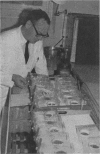Abstract
A solution of the problem of environmental contamination must be based on accurate measurement of the extent of the contamination and of the resulting hazards. This paper reviews the methods for the estimation of microchemical contaminants in water with the aid of living organisms. The methods are grouped according to the nature of the response of the organism to the contaminant—namely, acute response (usually death), behavioural change, physiological change, biochemical and histochemical change, ecological change, embryological and regenerational change, growth change, histological change and perception by man or aquatic organisms. Finally, the following problems are discussed: selection of appropriate tests and standardization, the dangers of sequential concentration and the need for multi-parametric assays (assays involving several responses of a single organism, or responses of several organisms) for complete characterization of the effects of a contaminant on the environment.
Full text
PDF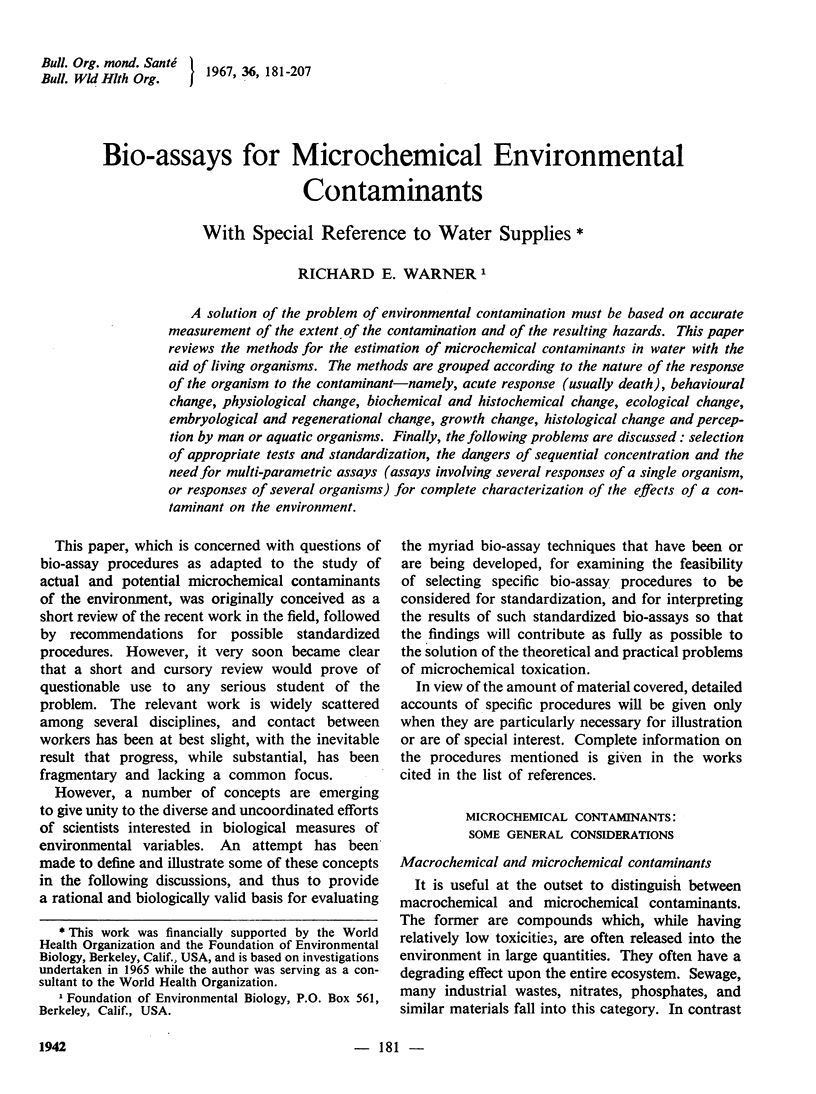
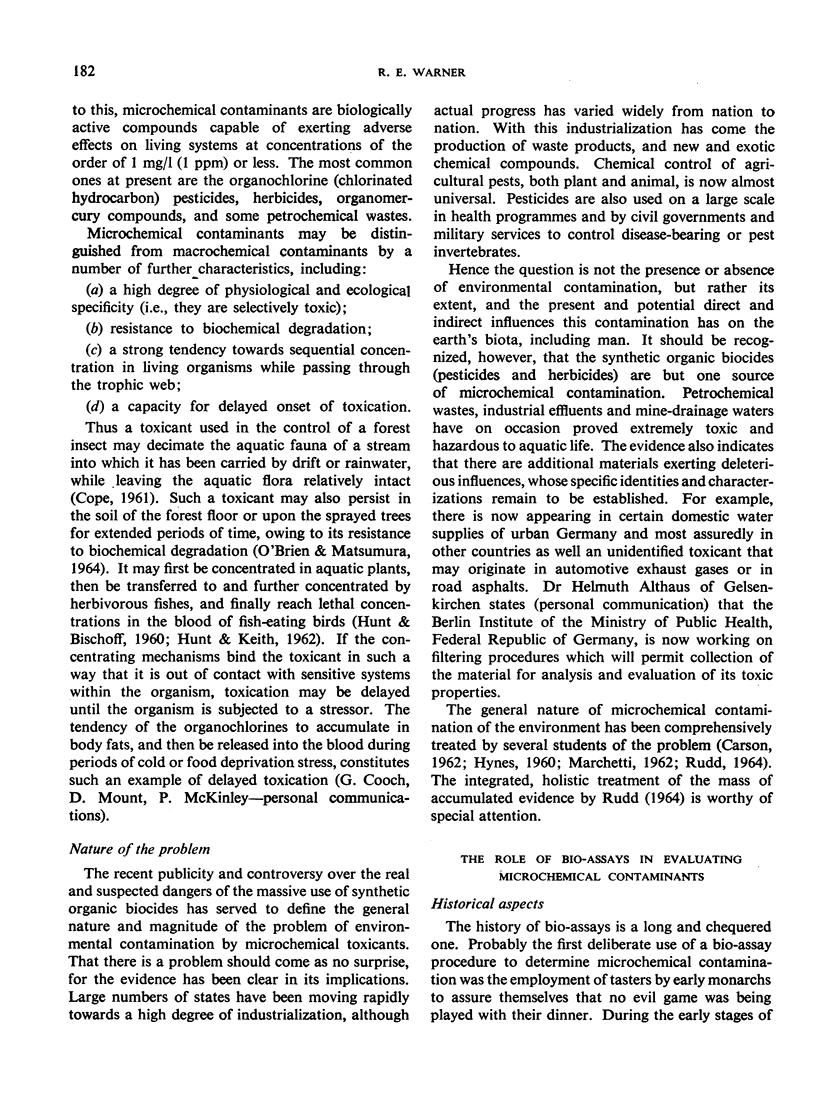
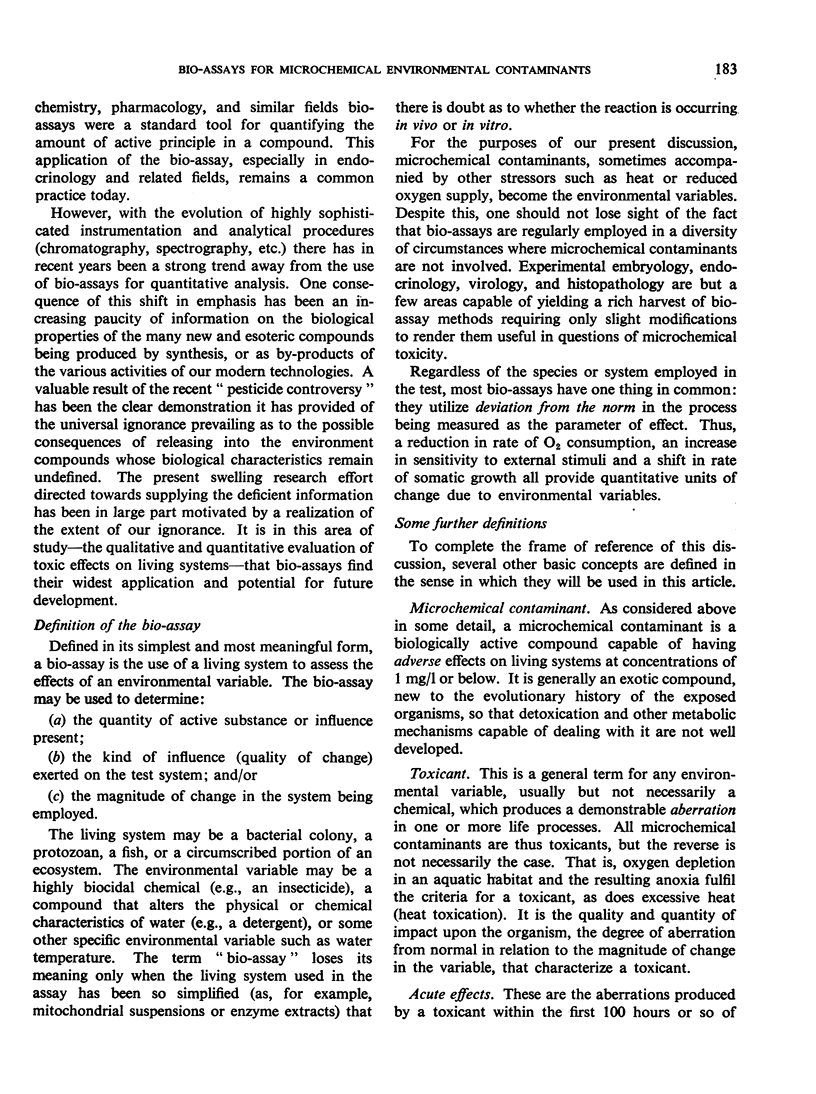
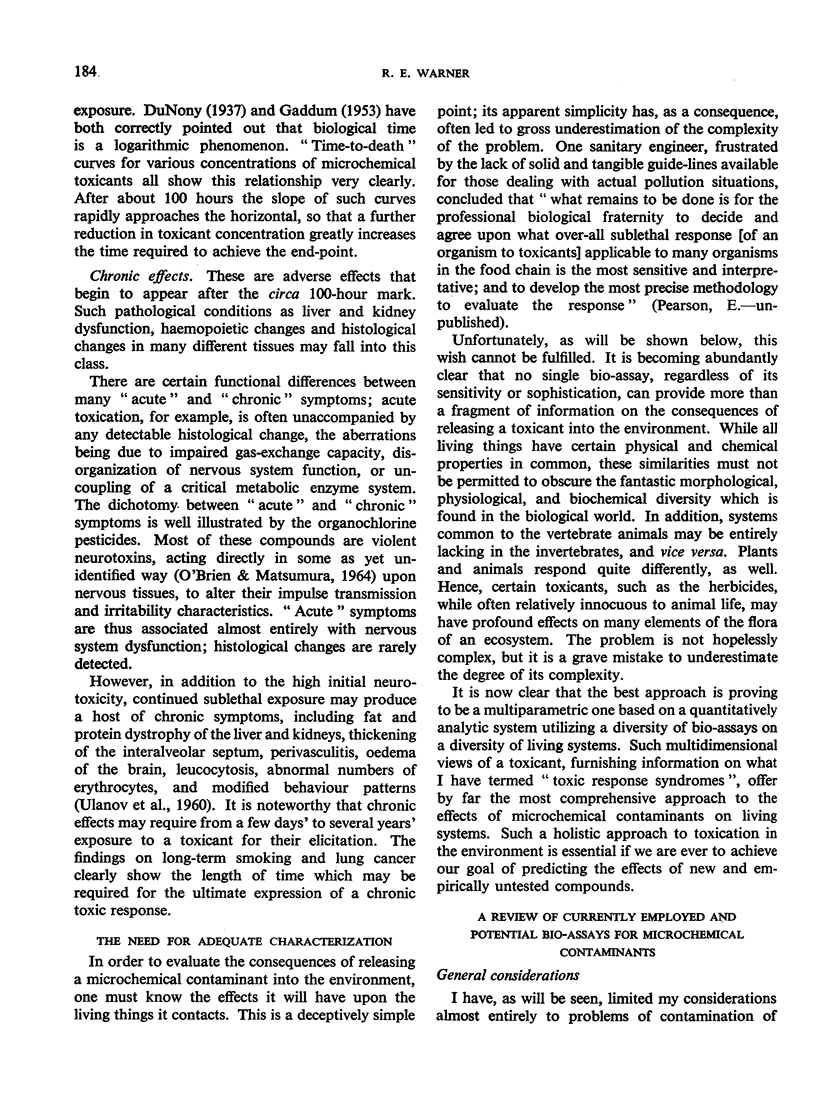
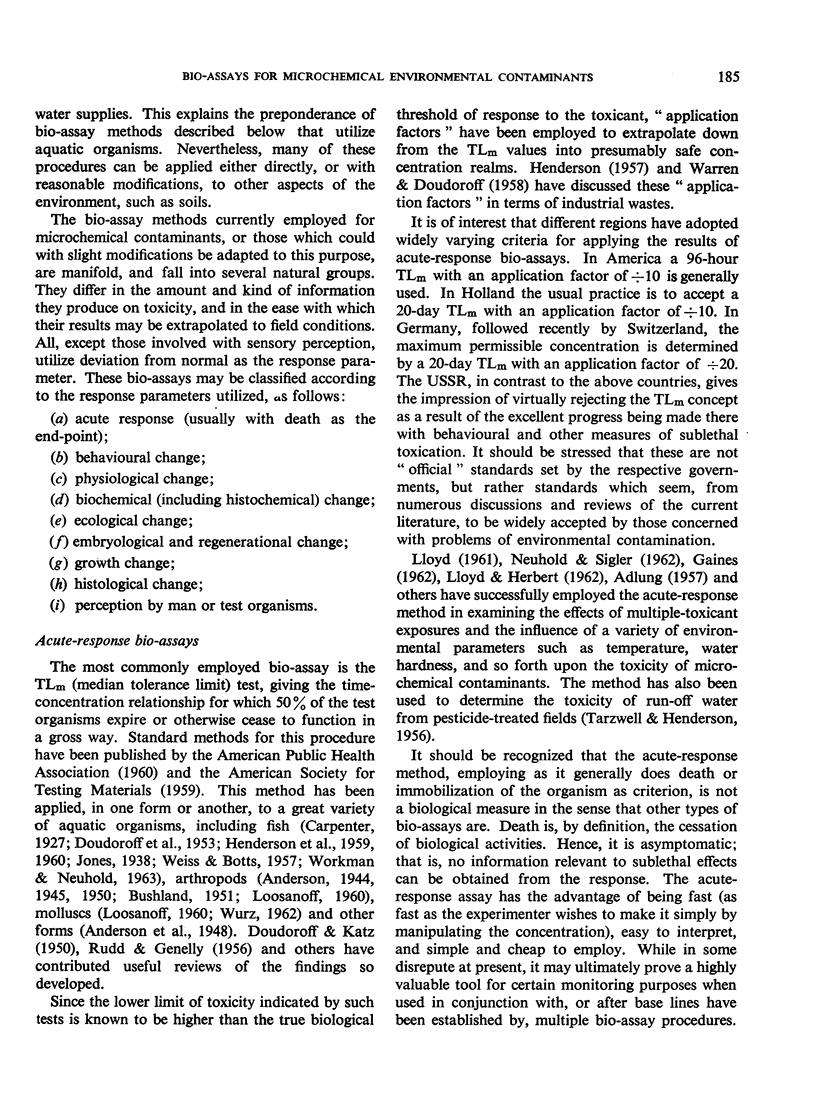
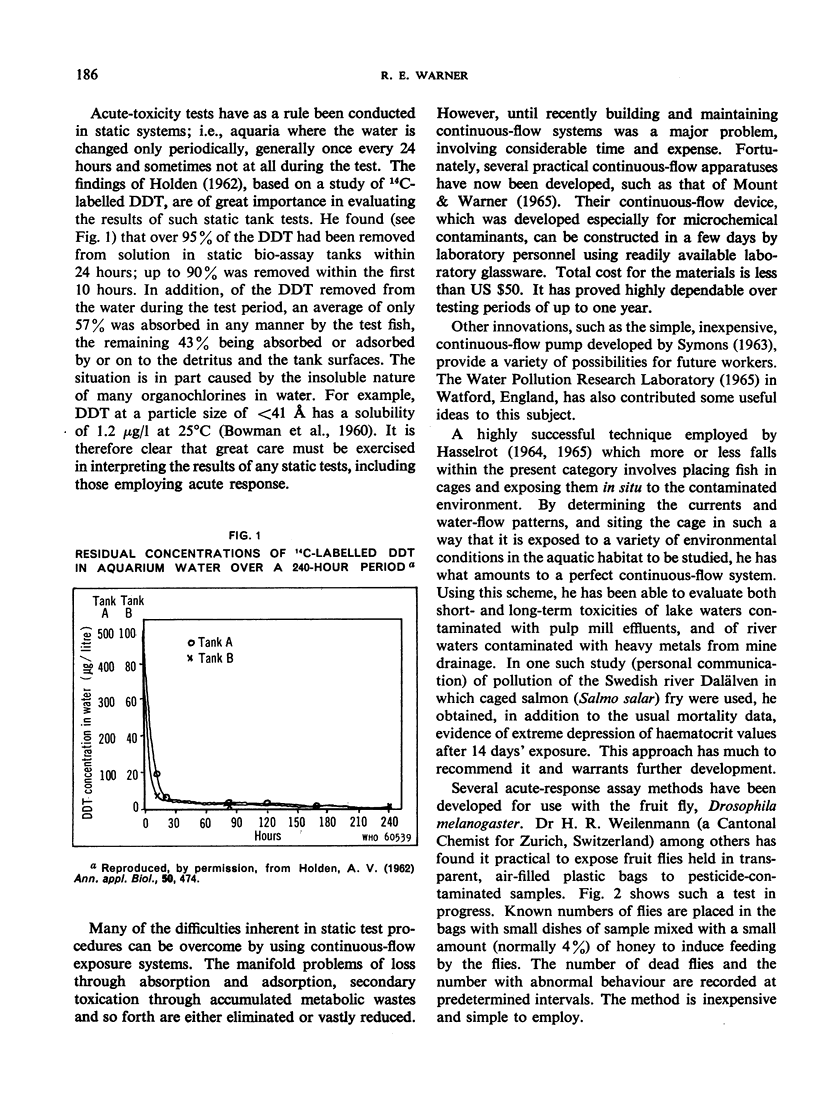
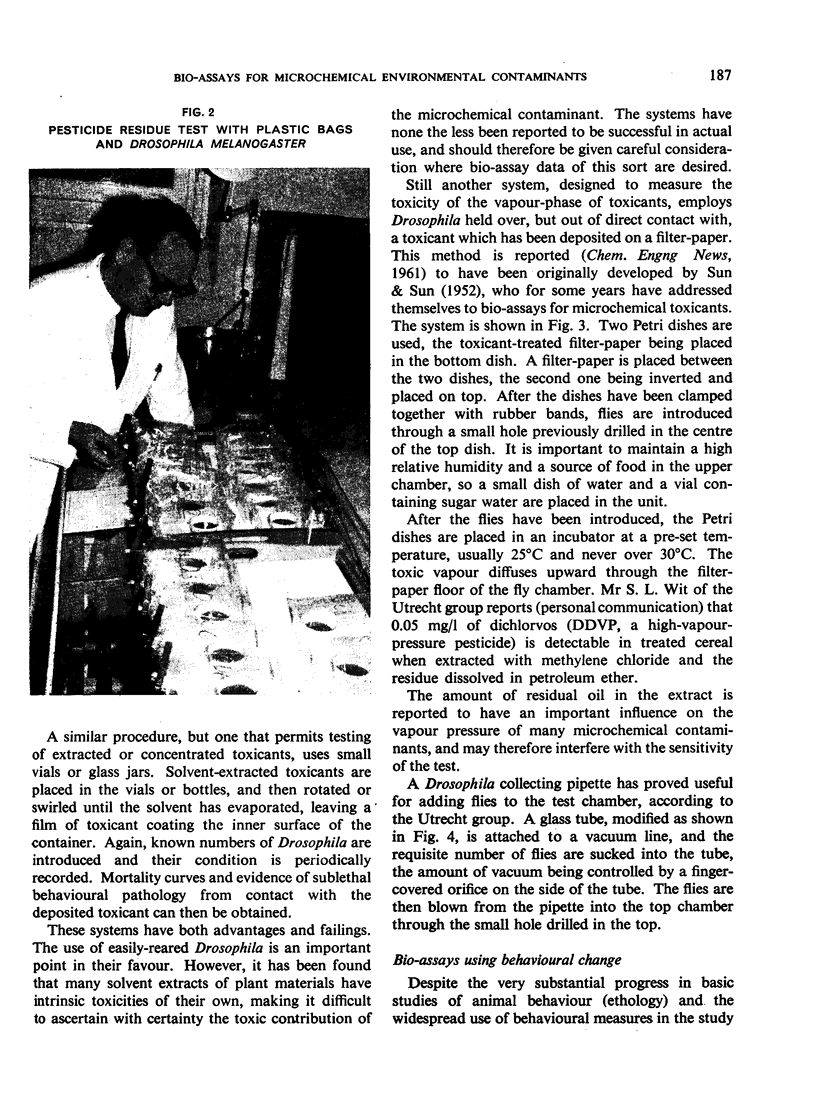
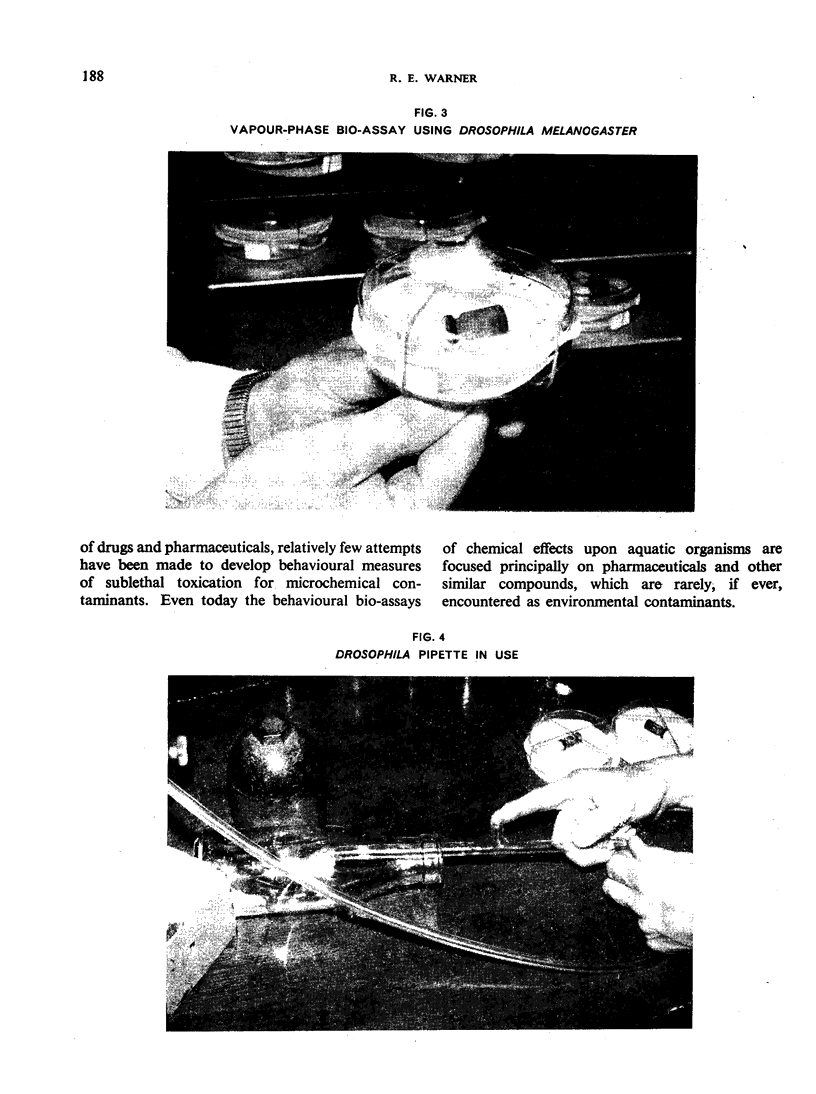
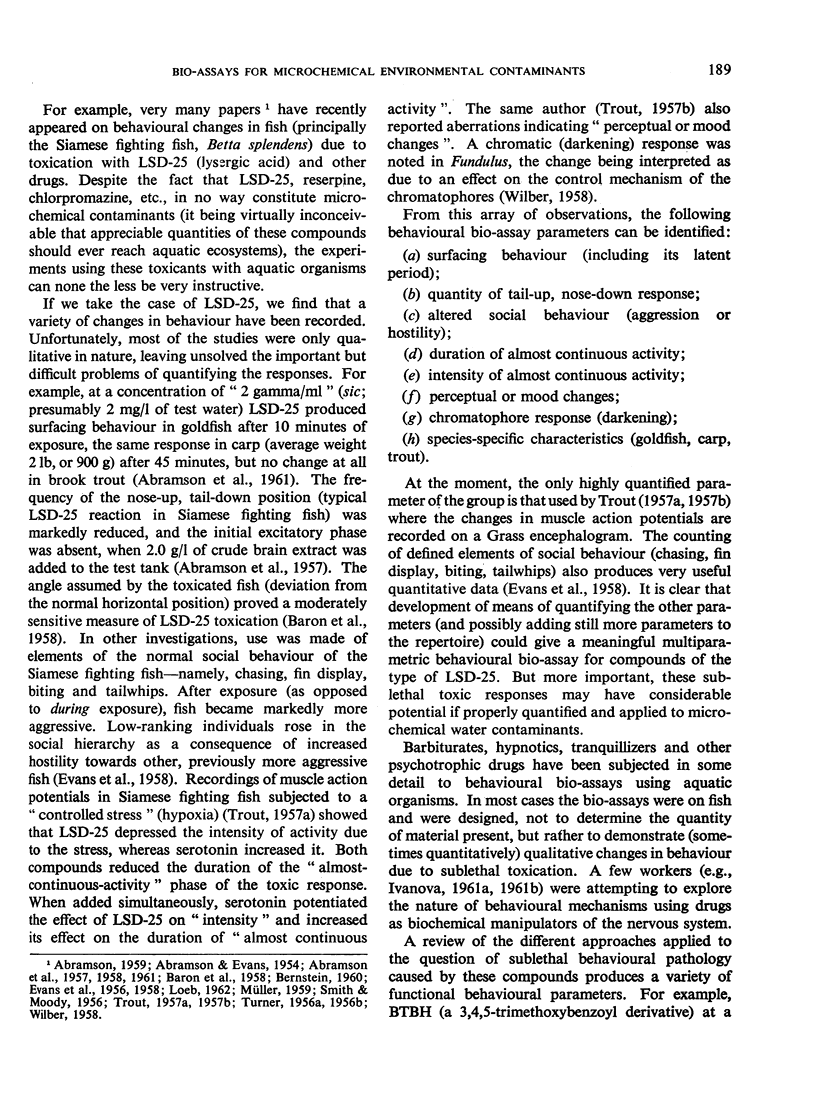
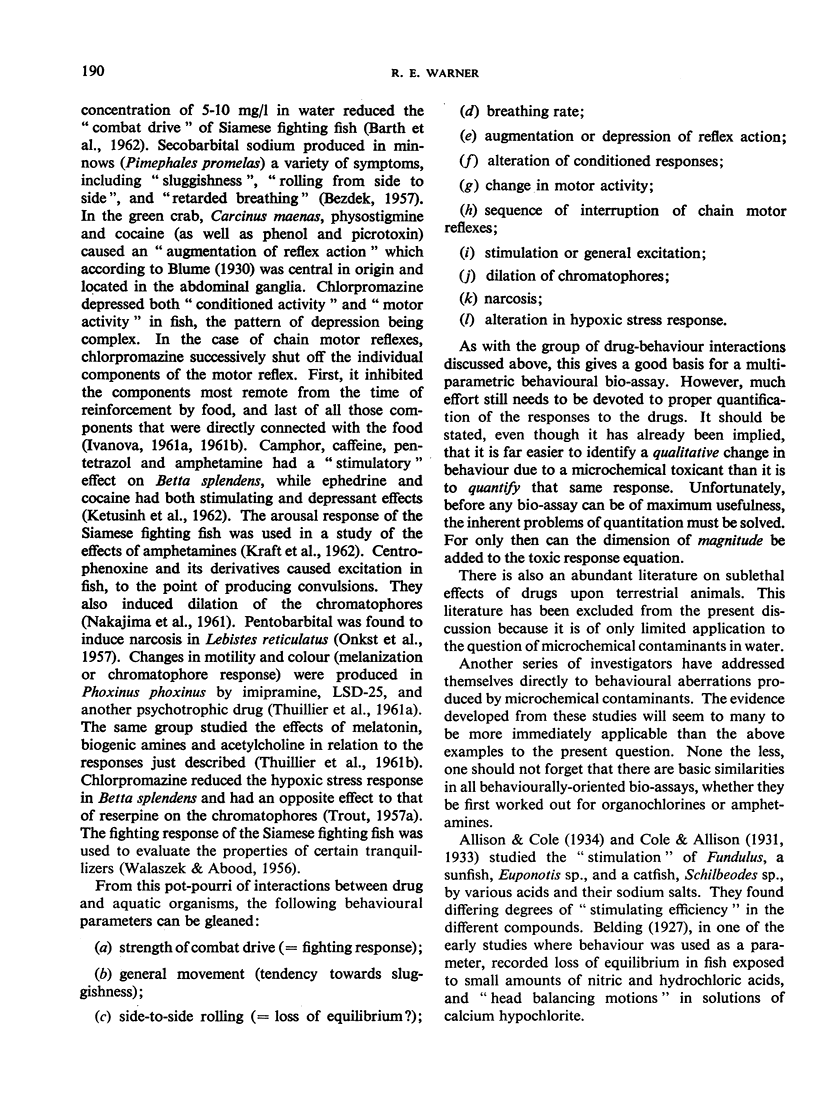
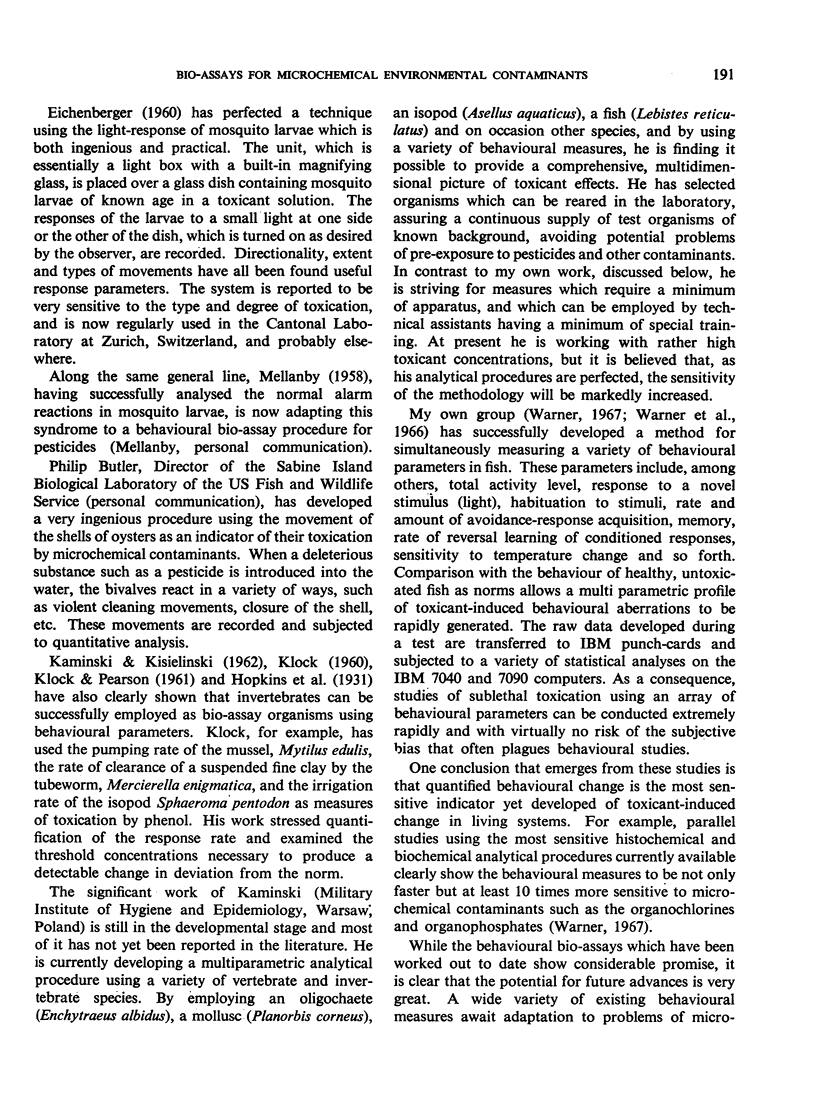
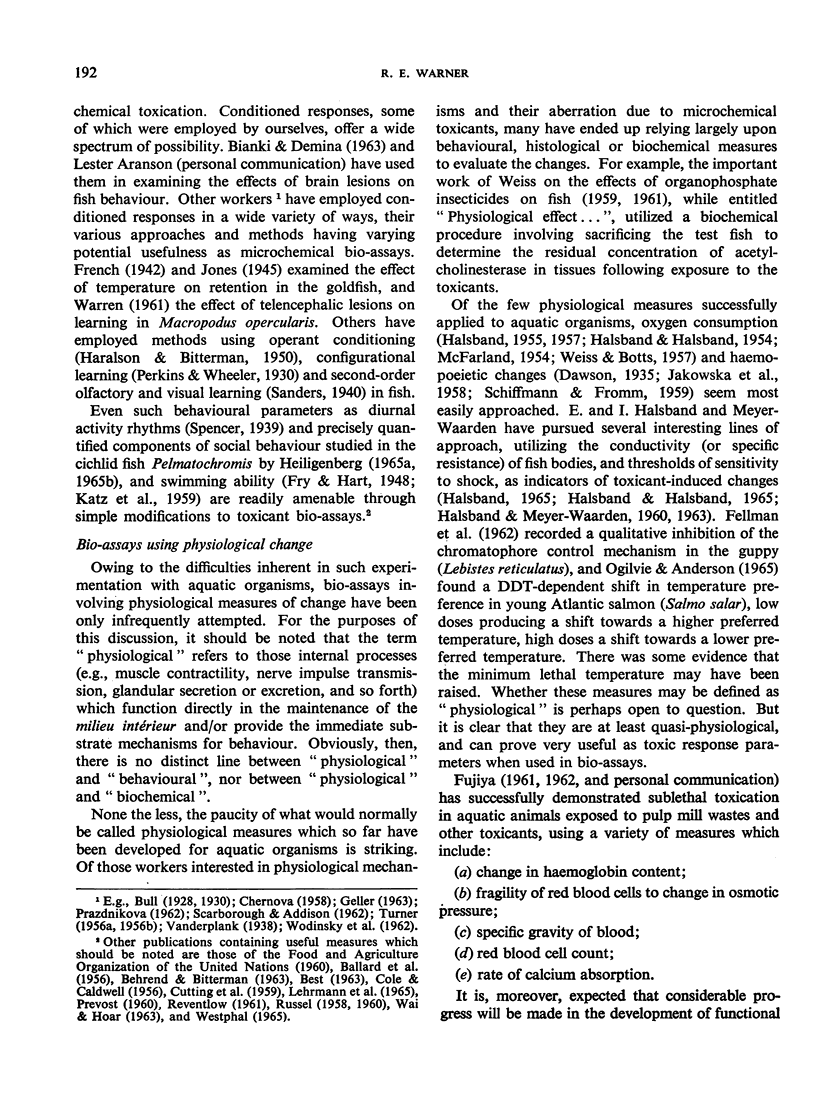
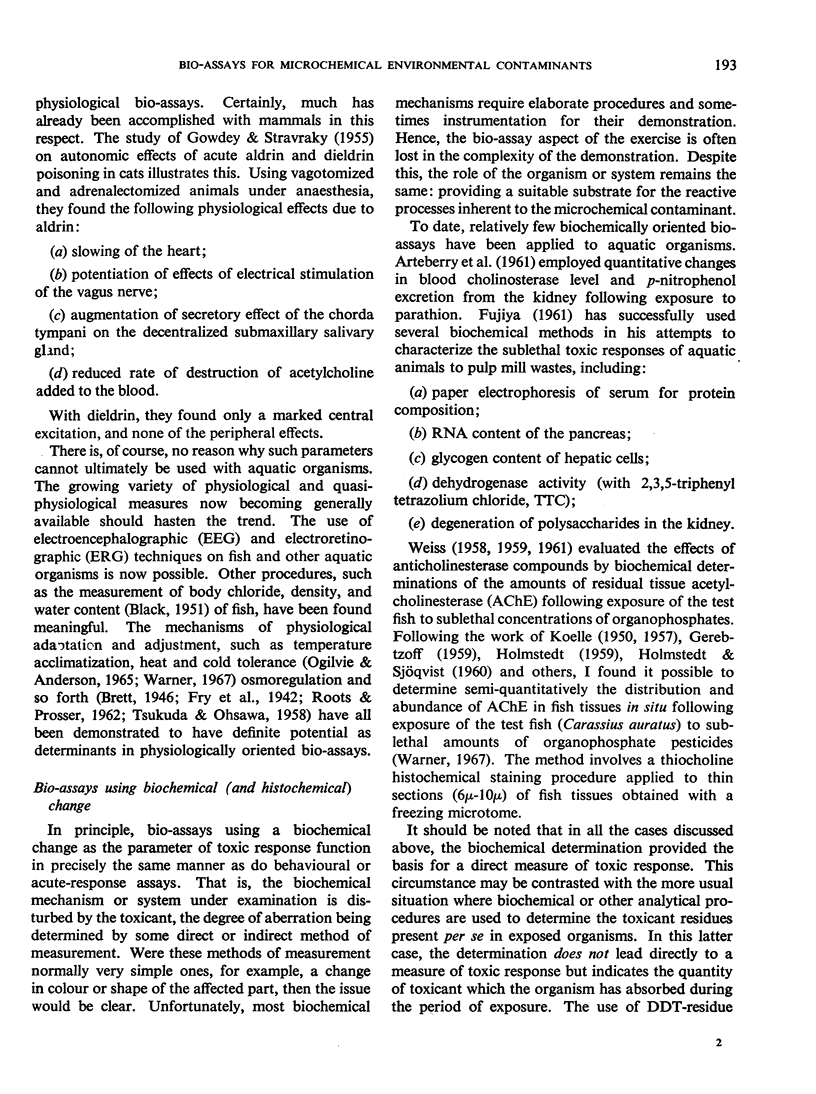
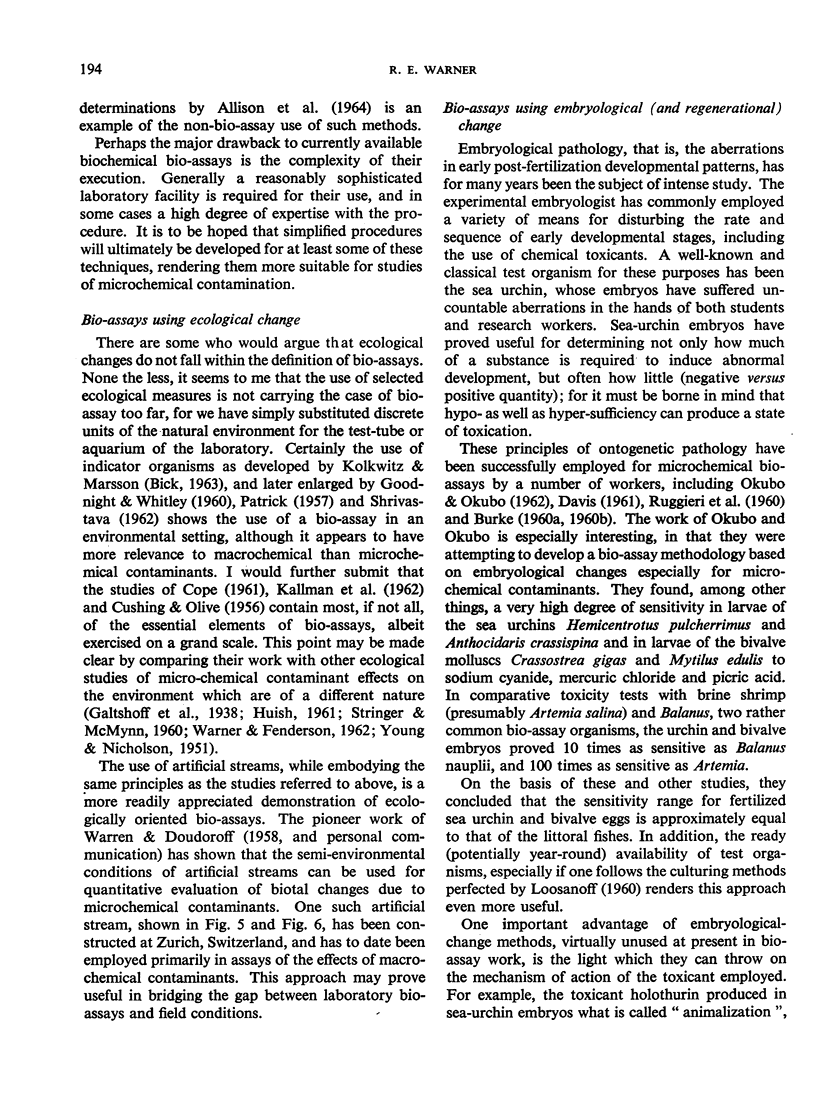
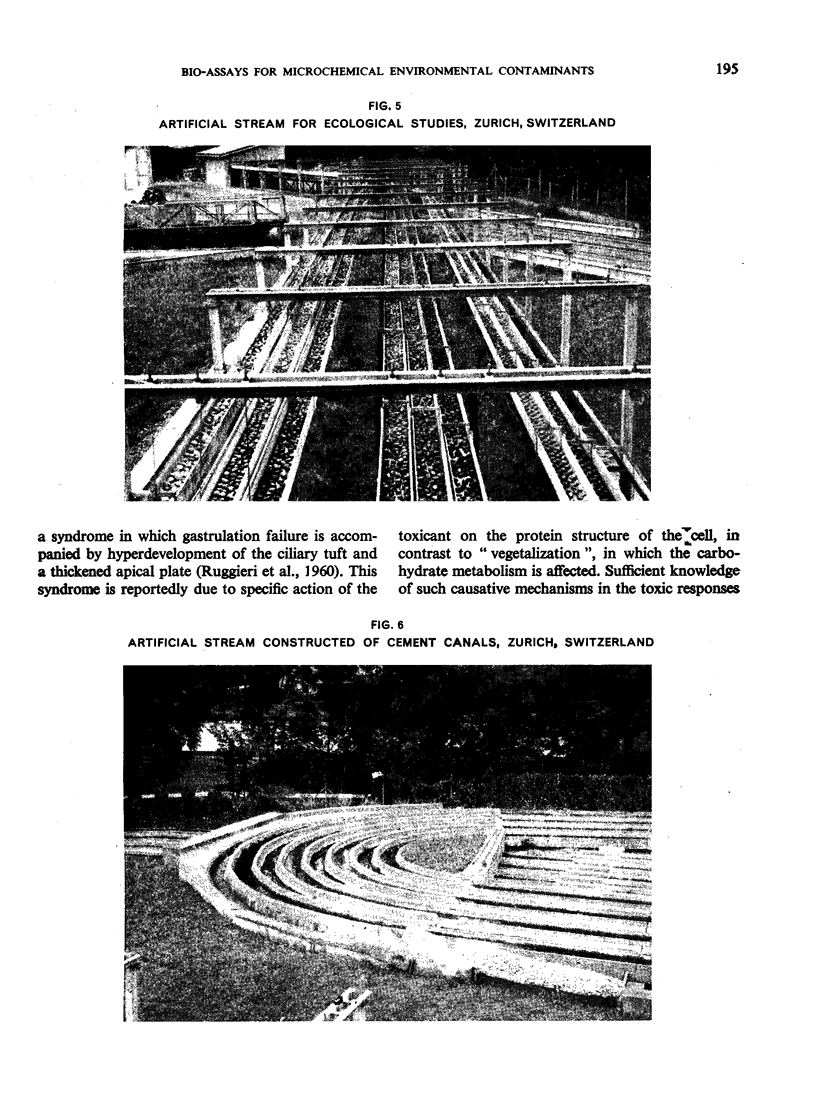
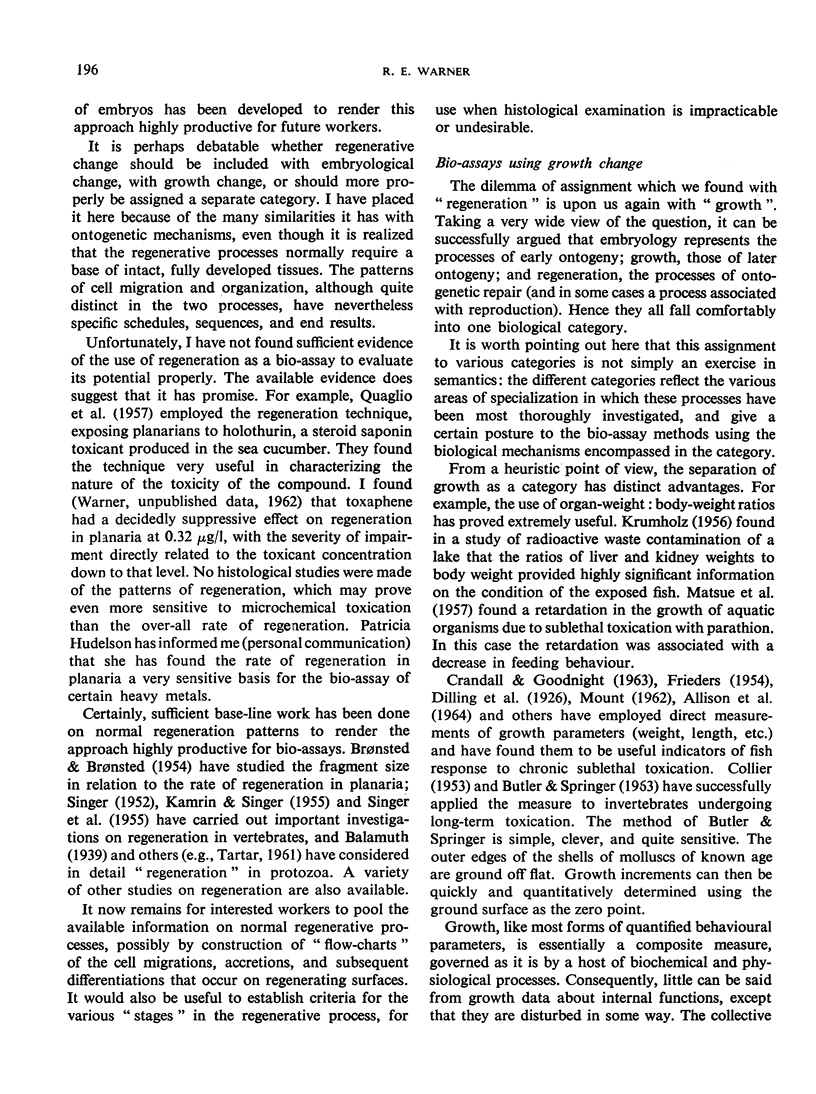
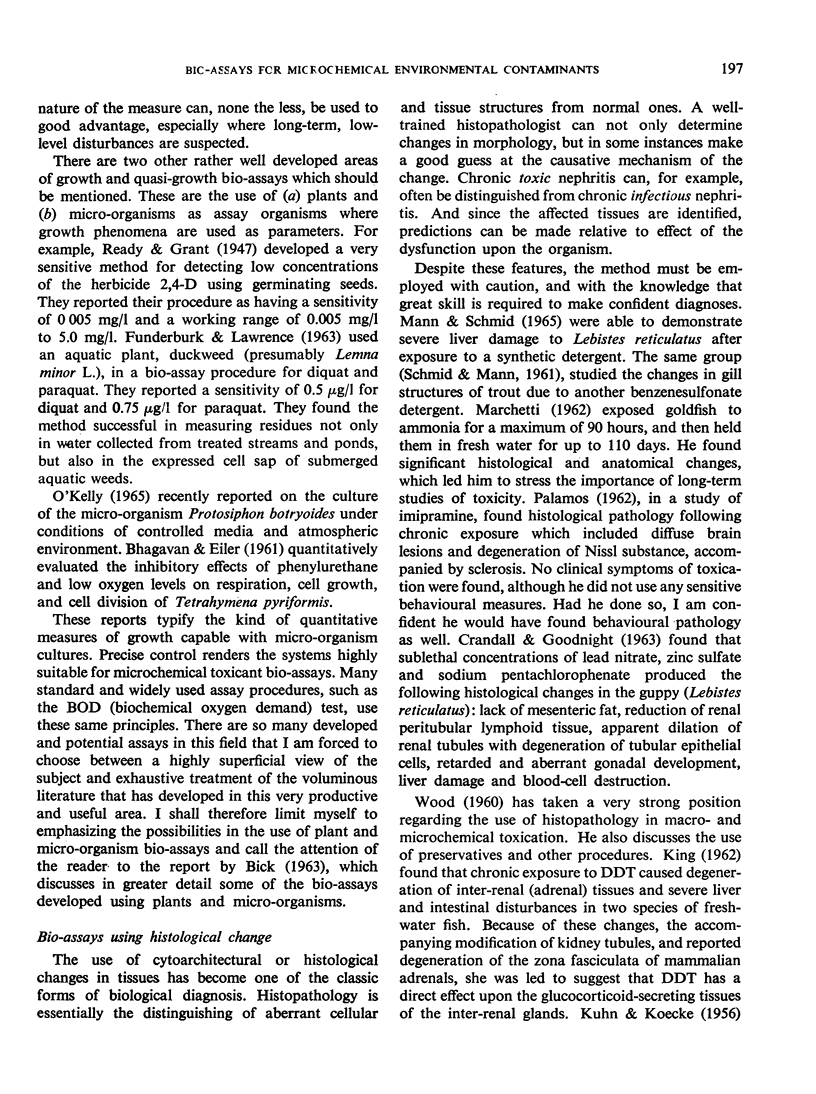
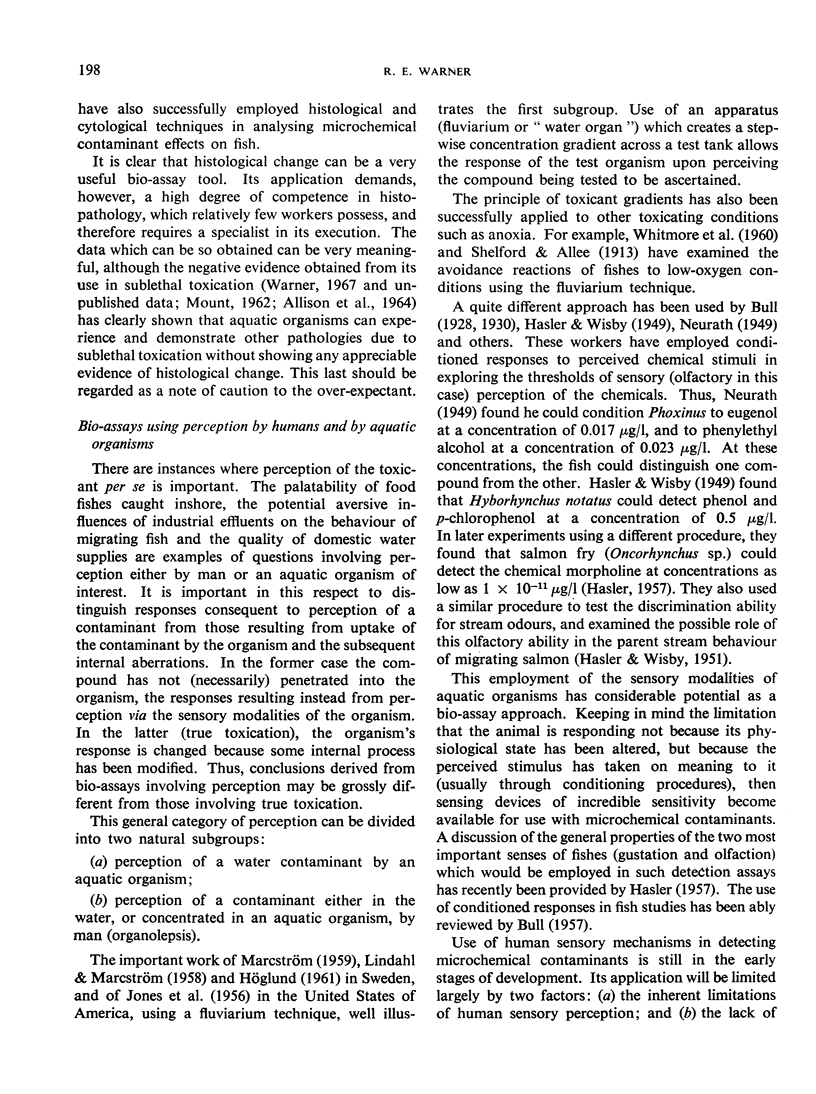
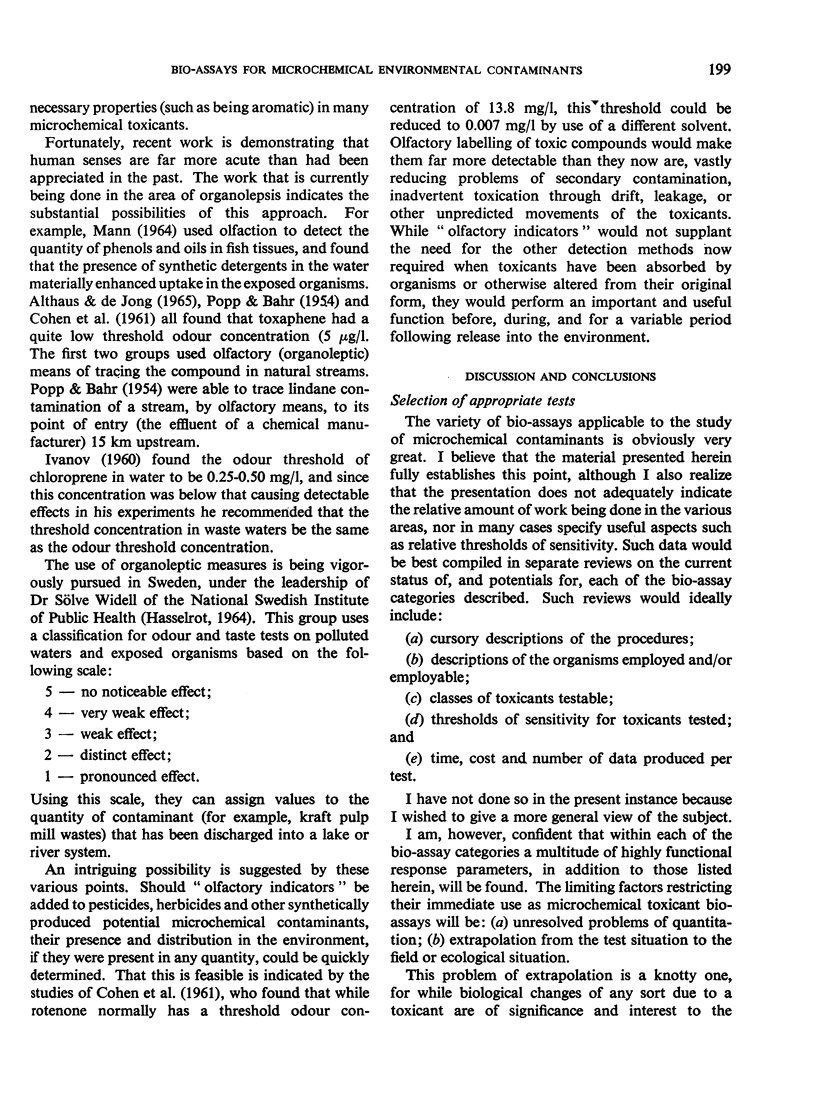
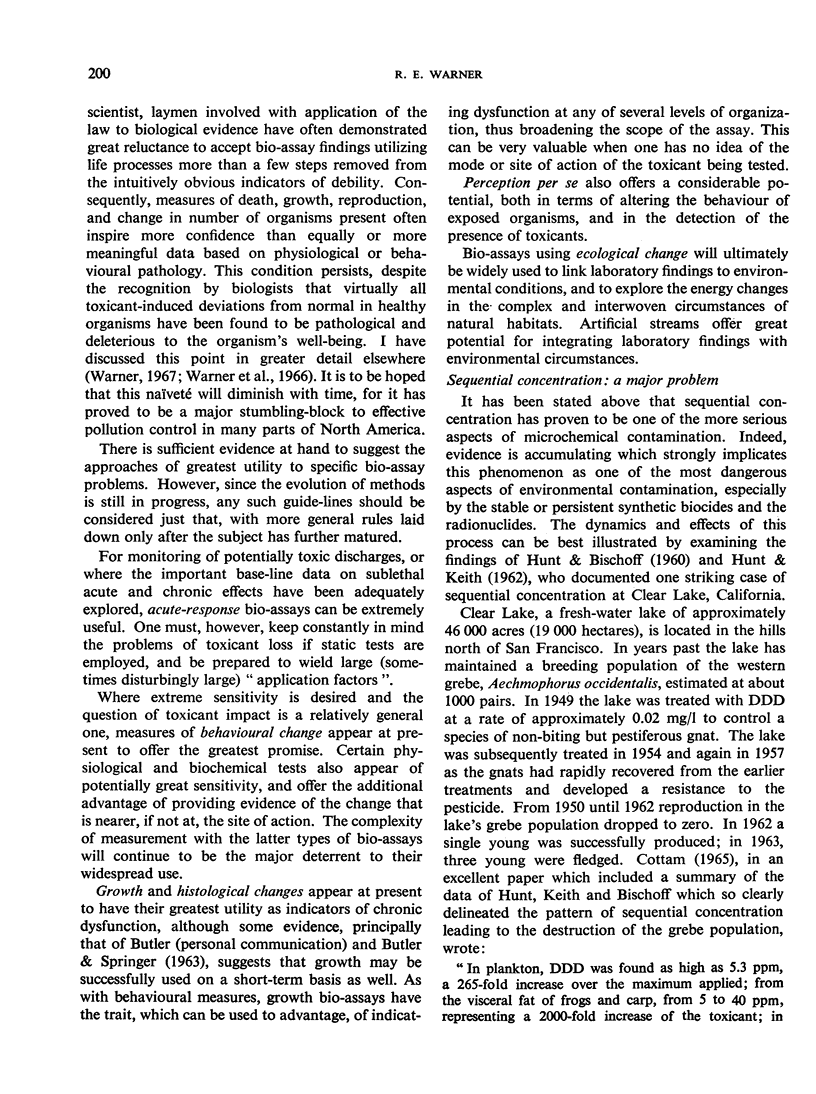
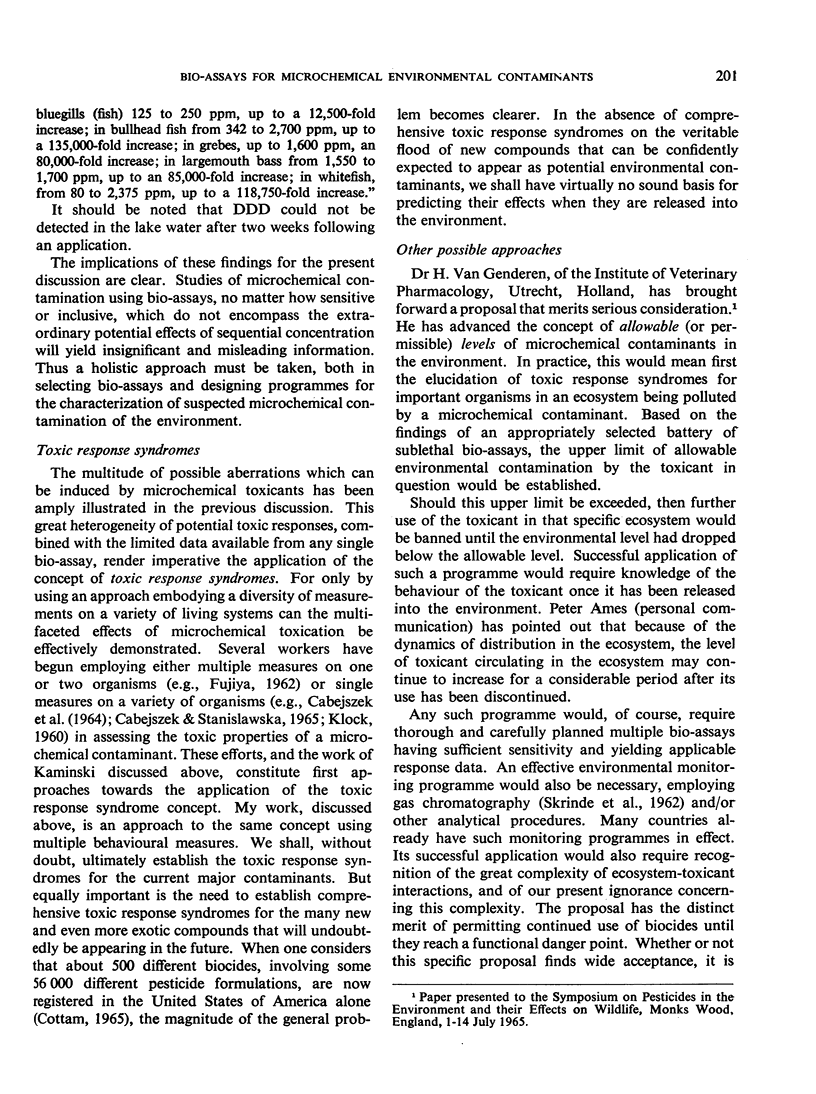
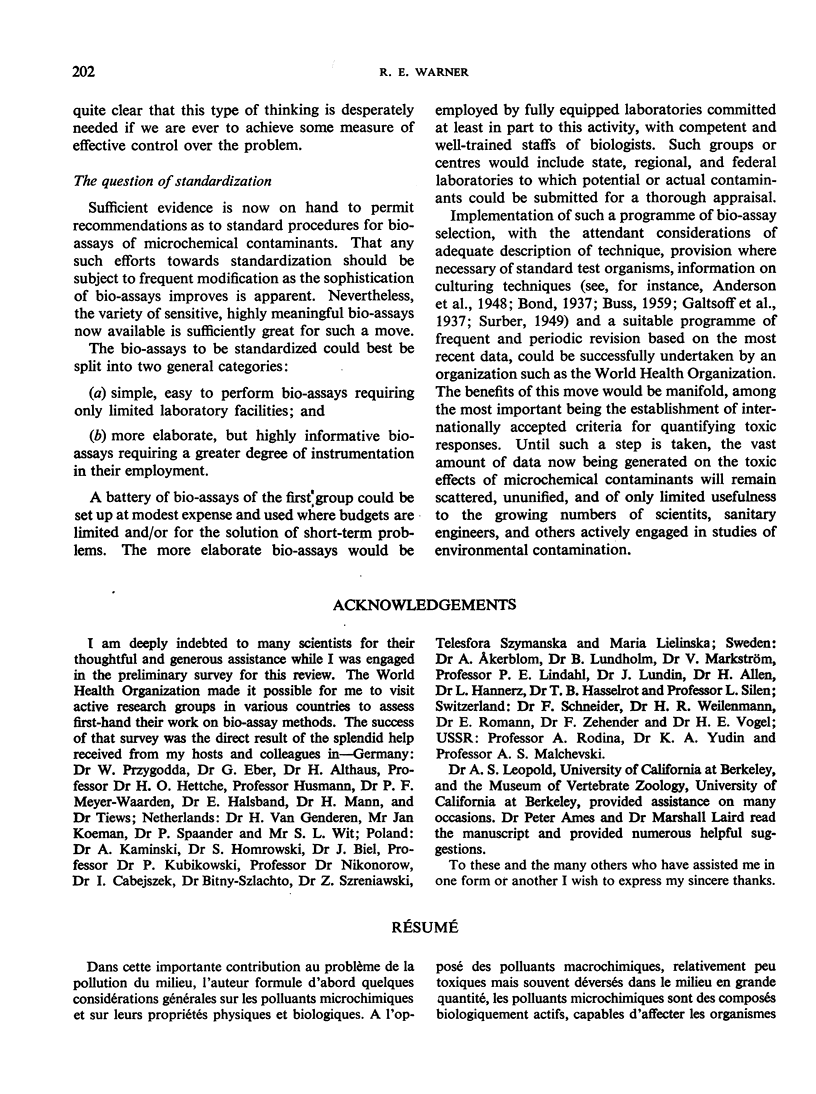
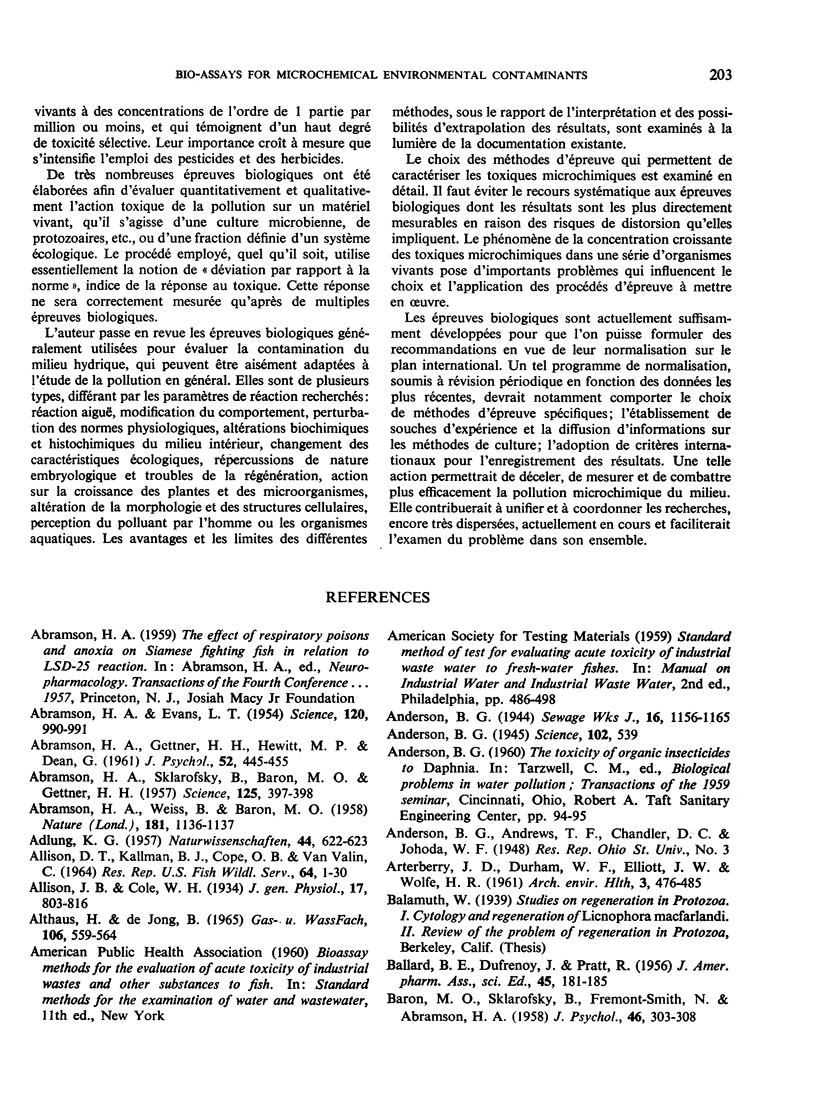
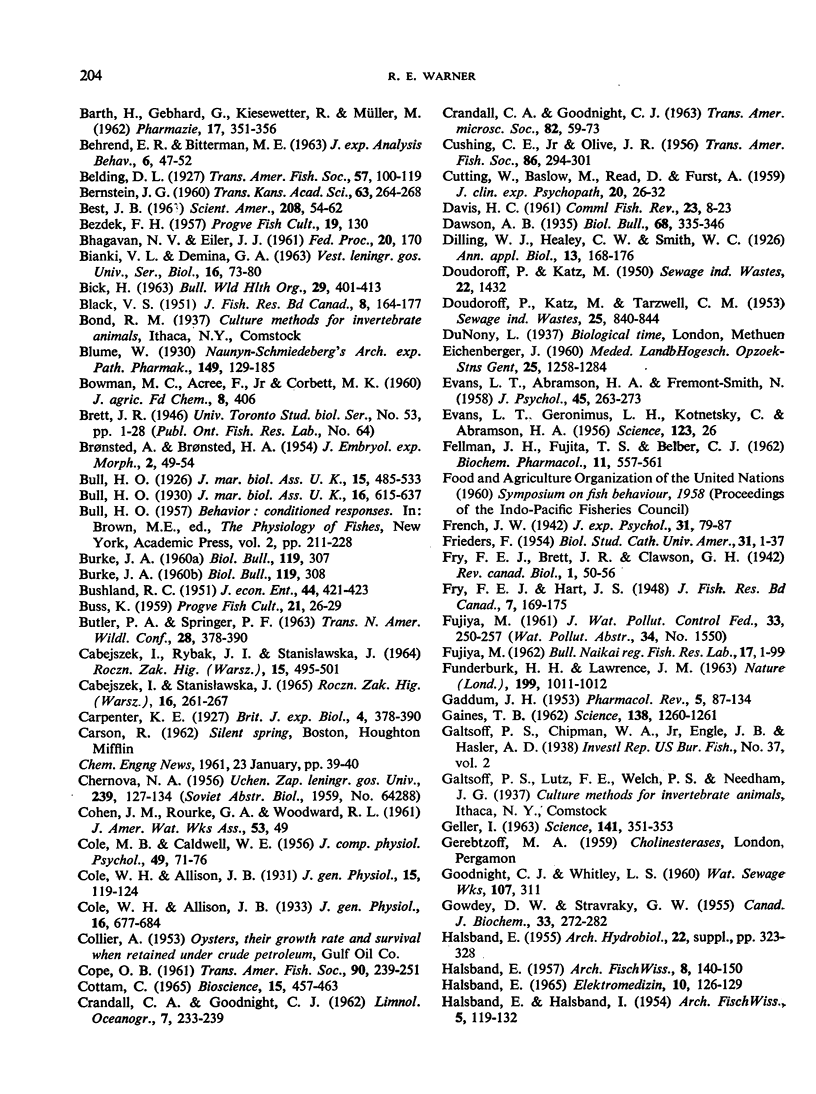
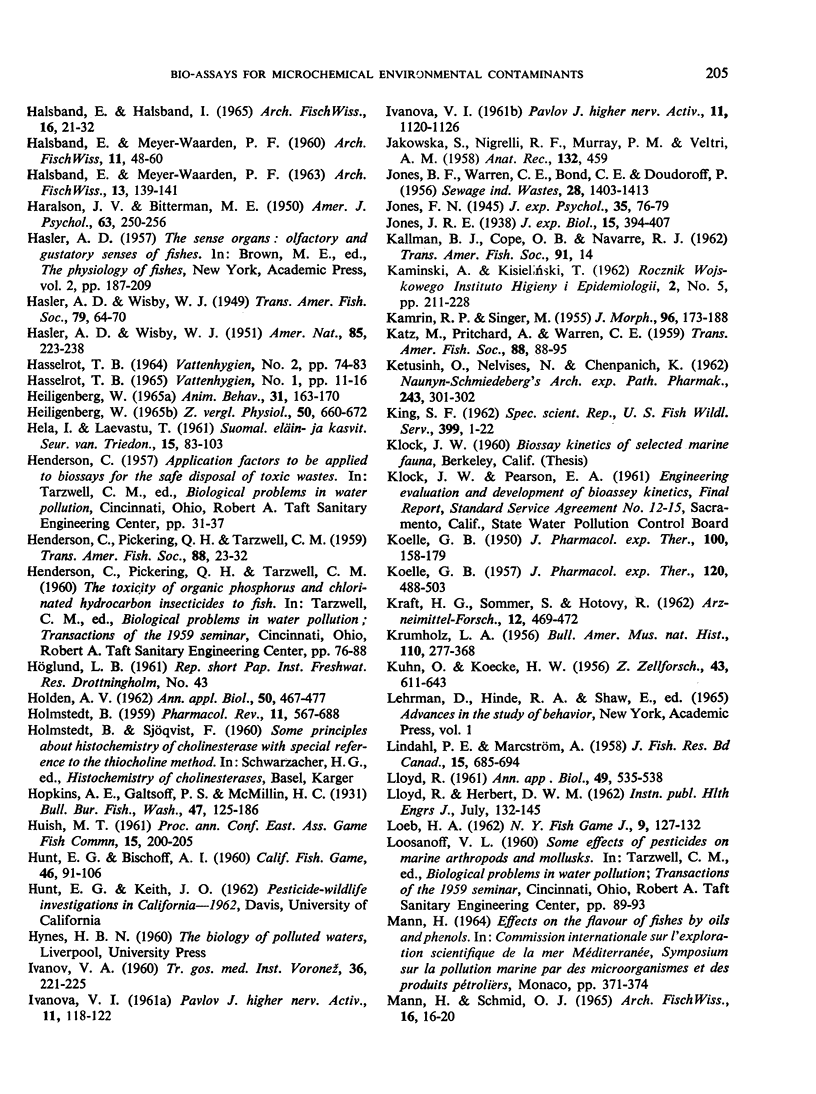
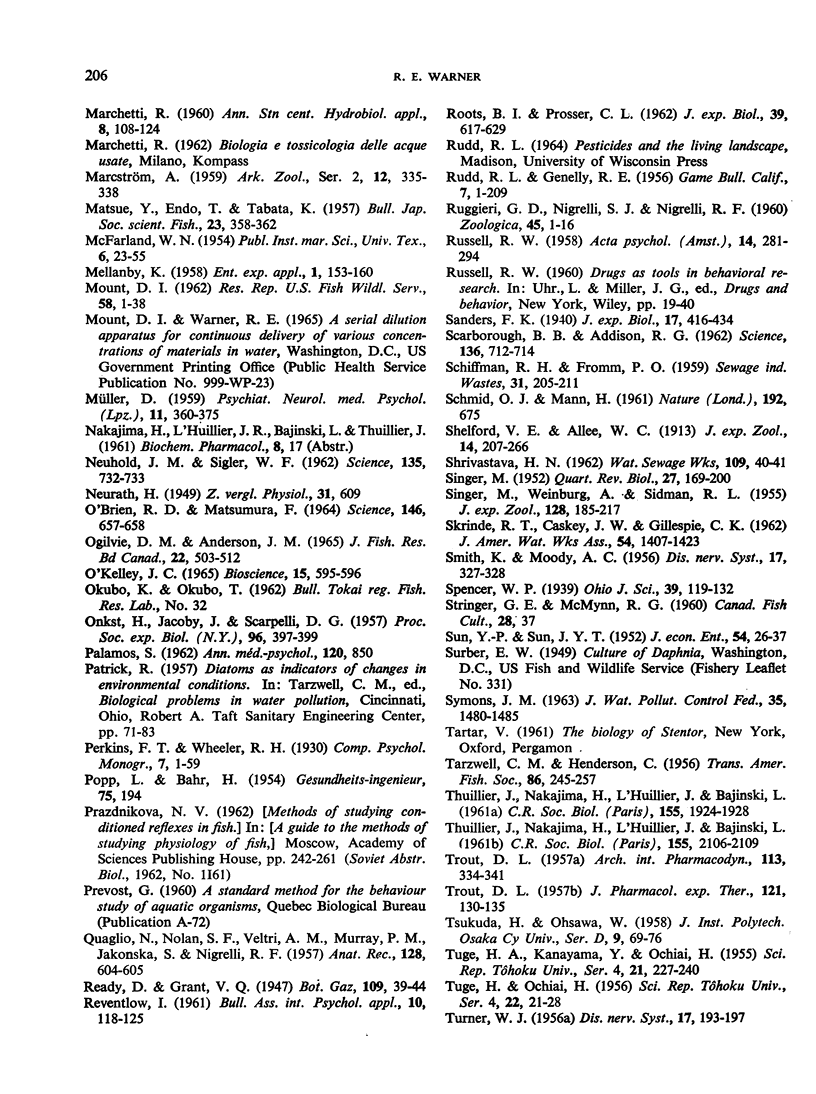
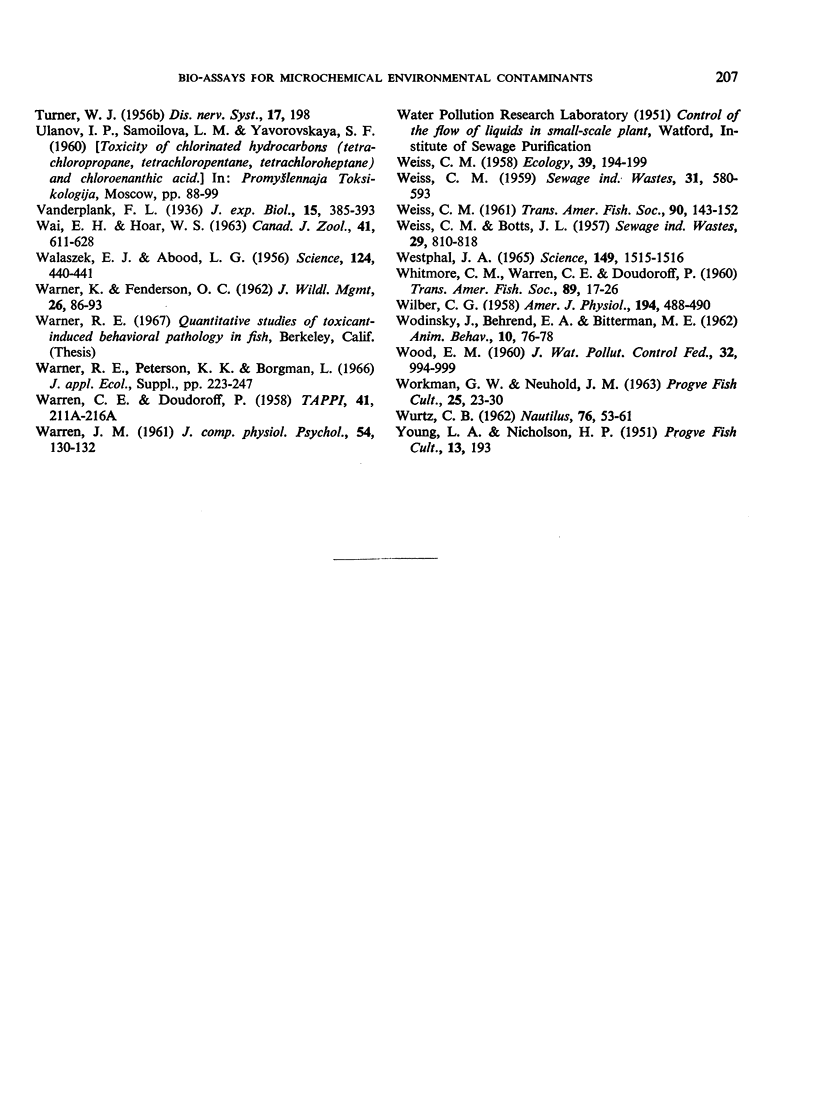
Images in this article
Selected References
These references are in PubMed. This may not be the complete list of references from this article.
- ABOOD L. G., WALASZEK E. J. Effect of tranquilizing drugs on fighting response of Siamese fighting fish. Science. 1956 Sep 7;124(3219):440–441. doi: 10.1126/science.124.3219.440. [DOI] [PubMed] [Google Scholar]
- ABRAMSON H. A., EVANS L. T. Lysergic acid diethylamide (LSD 25). II. Psychobiological effects on the Siamese fighting fish. Science. 1954 Dec 10;120(3128):990–991. doi: 10.1126/science.120.3128.990. [DOI] [PubMed] [Google Scholar]
- ABRAMSON H. A., SKLAROFSKY B., BARON M. O., GETTNER H. H. Blocking effect of brain extract on lysergic acid diethylamide reaction in Siamese fighting fish. Science. 1957 Mar 1;125(3244):397–398. doi: 10.1126/science.125.3244.397. [DOI] [PubMed] [Google Scholar]
- ARTERBERRY J. D., DURHAM W. F., ELLIOTT J. W., WOLFE H. R. Exposure to parathion. Measurement by blood cholinesterase level and urinary p-nitrophenol excretion. Arch Environ Health. 1961 Oct;3:476–485. doi: 10.1080/00039896.1961.10663054. [DOI] [PubMed] [Google Scholar]
- Allison J. B., Cole W. H. STIMULATION OF FUNDULUS BY HYDROCHLORIC AND FATTY ACIDS IN FRESH WATER, AND BY FATTY ACIDS, MINERAL ACIDS, AND THE SODIUM SALTS OF MINERAL ACIDS IN SEA WATER. J Gen Physiol. 1934 Jul 20;17(6):803–816. doi: 10.1085/jgp.17.6.803. [DOI] [PMC free article] [PubMed] [Google Scholar]
- Anderson B. G. THE TOXICITY OF DDT TO DAPHNIA. Science. 1945 Nov 23;102(2656):539–539. doi: 10.1126/science.102.2656.539. [DOI] [PubMed] [Google Scholar]
- BALLARD B. E., DUFRENOY J., PRATT R. The goldfish as a potentially useful animal for testing neurotoxicity of antibiotics. J Am Pharm Assoc Am Pharm Assoc. 1956 Mar;45(3):181–185. doi: 10.1002/jps.3030450315. [DOI] [PubMed] [Google Scholar]
- BEHREND E. R., BITTERMAN M. E. Sidman avoidance in the fish. J Exp Anal Behav. 1963 Jan;6:47–52. doi: 10.1901/jeab.1963.6-47. [DOI] [PMC free article] [PubMed] [Google Scholar]
- BICK H. A REVIEW OF CENTRAL EUROPEAN METHODS FOR THE BIOLOGICAL ESTIMATION OF WATER POLLUTION LEVELS. Bull World Health Organ. 1963;29:401–413. [PMC free article] [PubMed] [Google Scholar]
- BOEKELMAN W. A. Sodium content of erythrocytes in hyperthyroidism. Nature. 1958 Apr 19;181(4616):1136–1136. doi: 10.1038/1811136a0. [DOI] [PubMed] [Google Scholar]
- COLE M. B., CALDWELL W. E. The utilization of light as exteroceptive motivation in the comet goldfish (Carassius auratus). J Comp Physiol Psychol. 1956 Feb;49(1):71–76. doi: 10.1037/h0042489. [DOI] [PubMed] [Google Scholar]
- CUTTING W., BASLOW M., READ D., FURST A. The use of fish in the evaluation of drugs affecting the central nervous system. J Clin Exp Psychopathol. 1959 Jan-Mar;20(1):26–32. [PubMed] [Google Scholar]
- Cole W. H., Allison J. B. STIMULATION BY HYDROCHLORIC ACID IN THE CATFISH, SCHILBEODES. J Gen Physiol. 1931 Nov 20;15(2):119–124. doi: 10.1085/jgp.15.2.119. [DOI] [PMC free article] [PubMed] [Google Scholar]
- Cole W. H., Allison J. B. STIMULATION BY THE MINERAL ACIDS, HYDROCHLORIC, SULFURIC, AND NITRIC, IN THE SUNFISH EUPOMOTIS. J Gen Physiol. 1933 Mar 20;16(4):677–684. doi: 10.1085/jgp.16.4.677. [DOI] [PMC free article] [PubMed] [Google Scholar]
- EVANS L. T., GERONIMUS L. H., KORNETSKY C., ABRAMSON H. A. Effect of ergot drugs on Betta splendens. Science. 1956 Jan 6;123(3184):26–26. doi: 10.1126/science.123.3184.26. [DOI] [PubMed] [Google Scholar]
- FELLMAN J. H., FUJITA T. S., BELBER C. J. 2,3-Dihydro-5-hydroxytryptamine. Biochem Pharmacol. 1962 Jul;11:557–561. doi: 10.1016/0006-2952(62)90116-8. [DOI] [PubMed] [Google Scholar]
- GADDUM J. H. Bioassays and mathematics. Pharmacol Rev. 1953 Mar;5(1):87–134. [PubMed] [Google Scholar]
- GAINES T. B. Poisoning by organic phosphorus pesticides potentiated by phenothiazine derivatives. Science. 1962 Dec 14;138(3546):1260–1261. doi: 10.1126/science.138.3546.1260. [DOI] [PubMed] [Google Scholar]
- GELLER I. Conditioned "anxiety" and punishment effects on operant behavior of goldfish (carassius auratus). Science. 1963 Jul 26;141(3578):351–353. doi: 10.1126/science.141.3578.351. [DOI] [PubMed] [Google Scholar]
- GOWDEY C. W., STAVRAKY G. W. A study of the autonomic manifestations seen in acute aldrin and dieldrin poisoning. Can J Biochem Physiol. 1955 May;33(3):272–282. [PubMed] [Google Scholar]
- HARALSON J. V., BITTERMAN M. E. A lever-depression apparatus for the study of learning in fish. Am J Psychol. 1950 Apr;63(2):250–256. [PubMed] [Google Scholar]
- HOLMSTEDT B. Pharmacology of organophosphorus cholinesterase inhibitors. Pharmacol Rev. 1959 Sep;11:567–688. [PubMed] [Google Scholar]
- Halsband E. Eine elektrische Messmethode zur Bestimmung des Körperwiderstandes von Fischen. Elektromed Biomed Tech. 1965 Jul;10(3):126–129. [PubMed] [Google Scholar]
- KOELLE G. B. Histochemical demonstration of reversible anticholinesterase action at selective cellular sites in vivo. J Pharmacol Exp Ther. 1957 Aug;120(4):488–503. [PubMed] [Google Scholar]
- KOELLE G. B. The histochemical differentiation of types of cholinesterases and their localizations in tissues of the cat. J Pharmacol Exp Ther. 1950 Oct;100(2):158–179. [PubMed] [Google Scholar]
- KRAFT H. G., SOMMER S., HOTOVY R. [On the analgesic effect of 2-ethylamino-3-phenylnorbornane and other central stimulants]. Arzneimittelforschung. 1962 May;12:469–472. [PubMed] [Google Scholar]
- KUHN O., KOECKE H. U. Histologische und cytologische Veränderungen der Fischkieme nach Einwirkung im Wasser enthaltener schädigender Substanzen. Z Zellforsch Mikrosk Anat. 1956;43(6):611–643. [PubMed] [Google Scholar]
- MOODY A. C., SMITH K. Schizophrenia and the Siamese fighting fish. Dis Nerv Syst. 1956 Oct;17(10):327–328. [PubMed] [Google Scholar]
- NEUHOLD J. M., SIGLER W. F. Chlorides affect the toxicity of fluorides to rainbow trout. Science. 1962 Mar 2;135(3505):732–733. doi: 10.1126/science.135.3505.732. [DOI] [PubMed] [Google Scholar]
- O'BRIEN R. D., MATSUMURA F. DDT: A NEW HYPOTHESIS OF ITS MODE OF ACTION. Science. 1964 Oct 30;146(3644):657–658. doi: 10.1126/science.146.3644.657. [DOI] [PubMed] [Google Scholar]
- ONKST H., JACOBY J., SCARPELLI D. G. Effect of calcium binding substances on rate and duration of narcosis. Proc Soc Exp Biol Med. 1957 Nov;96(2):397–399. doi: 10.3181/00379727-96-23489. [DOI] [PubMed] [Google Scholar]
- ROOTS B. I., PROSSER C. L. Temperature acclimation and the newvous system in fish. J Exp Biol. 1962 Dec;39:617–629. doi: 10.1242/jeb.39.4.617. [DOI] [PubMed] [Google Scholar]
- SINGER M. The influence of the nerve in regeneration of the amphibian extremity. Q Rev Biol. 1952 Jun;27(2):169–200. doi: 10.1086/398873. [DOI] [PubMed] [Google Scholar]
- Scarborough B. B., Addison R. G. Conditioning in Fish: Effects of X-irradiation. Science. 1962 May 25;136(3517):712–714. doi: 10.1126/science.136.3517.712. [DOI] [PubMed] [Google Scholar]
- THUILLIER J., NAKAJIMA H., L'HUILLIER J., BAGINSKI L. [Influence of melatonine, biogenic amines and acetylcholine on the reactions of Phoxinus phoxinus Linne induced by certain psychotropic drugs]. C R Seances Soc Biol Fil. 1961;155:2106–2109. [PubMed] [Google Scholar]
- THUILLIER J., NAKAJIMA H., L'HUILLIER J., BAGINSKI L. [Study of the behavior and the changes in color of Phoxinus phoxinus L., subjected to the action of psychotropic drugs. Influence of pH and the composition of the medium]. C R Seances Soc Biol Fil. 1961;155:1924–1928. [PubMed] [Google Scholar]
- TROUT D. L. Interaction of serotonin and lysergic acid diethylamide in the Siamese fighting fish. J Pharmacol Exp Ther. 1957 Sep;121(1):130–135. [PubMed] [Google Scholar]
- TURNER W. J. The effect of lysergic acid diethylamide on Betta splendens. I. Dis Nerv Syst. 1956 Jun;17(6):193–197. [PubMed] [Google Scholar]
- TURNER W. J. The effect of lysergic acid diethylamide on Betta splendens. II. Frenquel. Dis Nerv Syst. 1956 Jun;17(6):198–198. [PubMed] [Google Scholar]
- WARREN J. M. The effect of telencephalic injuries on learning by paradise fish, Macropodus opercularis. J Comp Physiol Psychol. 1961 Apr;54:130–132. doi: 10.1037/h0044265. [DOI] [PubMed] [Google Scholar]
- WILBER C. G. Chromatic responses of Fundulus to lysergic acid. Am J Physiol. 1958 Sep;194(3):488–490. doi: 10.1152/ajplegacy.1958.194.3.488. [DOI] [PubMed] [Google Scholar]
- Westphal A., Minning W. Parasitäre Erkrankungen des Enddarmes. Landarzt. 1965 Dec 20;41(35):1511–1516. [PubMed] [Google Scholar]



